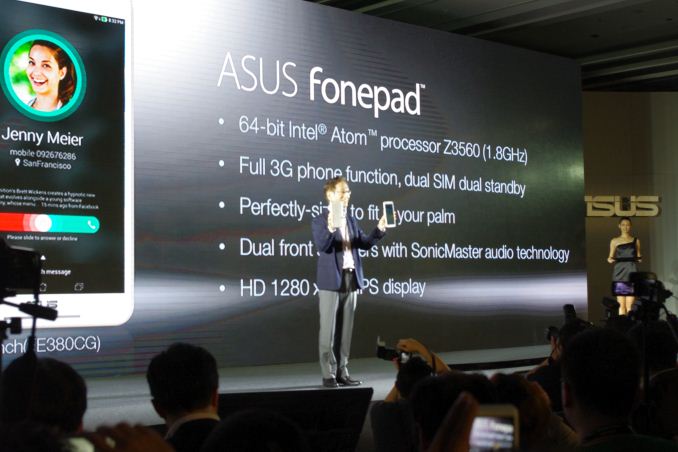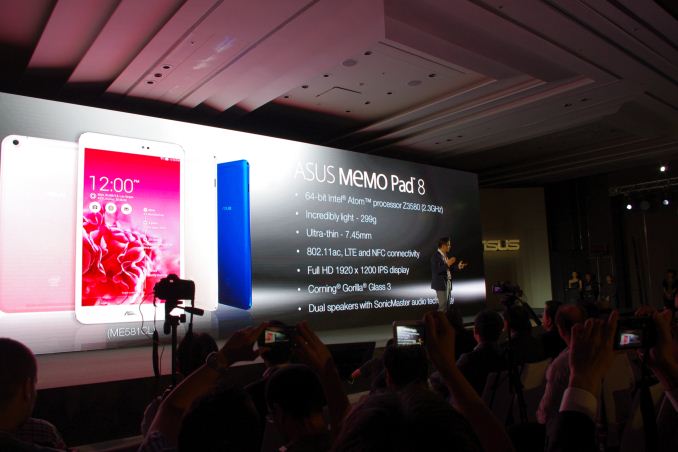Computex 2014: All new Intel Atom based Fonepad 8, MeMO Pad 7, MeMO Pad 8
by Ian Cutress on June 2, 2014 10:21 AM EST- Posted in
- Tablets
- Intel
- Atom
- Asus
- Mobile
- Silvermont
- MeMO Pad
- fonepad
- Computex 2014
_678x452.png)
Alongside the smartphone element inside the Transformer Book V announced today, it would seem that the Silvermont-based Intel Atom series is pushing more in to the mass market via ASUS, with ASUS’ new announcements today for the Fonepad 8 and the MeMO Pad 7/8 as well.
The Fonepad 8 (FE380CG) is the next iterative design on the previous model, essentially a tablet-as-a-phone, this time with an 8-inch 3G connected device sporting a 5.06mm bezel for a 72.2% screen-to-body ratio. The display comes in at 1280x800 IPS, with the CPU quoted as a quad-core Intel Atom Z3580 (1.8 GHz) as well as dual-SIM functionality. My own experience with large phones makes them perfectly fine for calling, but as long as the device can be answered with one hand effectively rather than two, for example when carrying a cup of coffee from the office.
ASUS showcased two new MeMO Pad devices, again both using Intel Atom as the processor. The MeMO Pad 7 (ME176C) is a 64-bit Atom Z3745 quad core device with support for Miracast and NFC. The 1280x800 display in the Pad 7 is an IPS panel, with the dual PixelMaster cameras at 5MP and 2MP. The MeMO Pad 7 will go on sale in Taiwan on June 6th, with other regions being considered.
The MeMO Pad 8 (ME481CL) is a big upgrade over the Pad 7, featuring LTE support, 802.11ac and a quad core Intel Atom Z3580 (2.3 GHz) at the helm. The display is upgraded to 1920x1080, covered with Corning Gorilla Glass 3. The design weighs 299g, is only 7.45mm thick and features a multi-layer coating with non-conductive vacuum metallization technology. Judging by the name of this coating, I would assume that it is a deposition under vacuum that instigates a metal effect, though in order to be non-conductive it would be without metal, unless the deposition of the film is over a metal body.
Both the new FonePad and MeMO Pad will ship with ASUS’ ZenUI, which should feature over 1000 new enhancements. No word on pricing or release outside Taiwan yet, however we will be visiting by the ASUS booth later in the week and I will try and find some more information.













15 Comments
View All Comments
themossie - Monday, June 2, 2014 - link
I assume these are all running Android? Excited to finally see Bay Trail Android tablets (with cellular!), although I'd find it hard to resist a full Windows 8 8" cellphone due to mild insanity :-)ssiu - Monday, June 2, 2014 - link
I am still wary about buying x86 Android devices because of app compatibility. I understand that the majority of Android apps should work fine, while a minority (mostly games??) has ARM-specific code and won't run (or run at slow-emulator-speed or has glitches) on x86 devices. Is that still correct perception or is it outdated?Wilco1 - Monday, June 2, 2014 - link
This is what ARM says about that, almost half of the top 100 Android apps/games need binary translation, and that has a high penalty: http://www.theregister.co.uk/2014/05/02/arm_test_r...evonitzer - Monday, June 2, 2014 - link
Anectdotally, I haven't had any problems with my Razr i, which is a Medfield phone (so pretty stinkin old). I do not live on the bleeding edge, so perhaps I would run into trouble if I tried to run more apps. There are some slowdowns, but I am not sure if it is a consequence of it being a 2 year old phone, or the fact that it is emulating. I'm always tempted by the Fonepads, so perhaps I'll get this version and I can tell better where the incompatibilities are.ussfletcher - Monday, June 2, 2014 - link
You wouldn't run in to any real troubles with anything that is soley running in the Dalvik VM or ART to a lesser extent, there are applications however that utilize the native code libraries (compiled C) to run. As such these would have to be compiled for x86.evonitzer - Tuesday, June 3, 2014 - link
Yes, I understand that. But is there a way to know how an app is compiled just by looking at it? Or if they are using ARM native code?hamoboy - Monday, June 2, 2014 - link
I'm using an ASUS Zenfone 5, and it's pretty good, especially for the price they're sold for. CPU is beefy, GPU is OK, most apps fly on it, but there's always that one app (normally a game) that will stutter or just refuse to run sometimes. ARM's report that more than half of the top 100 apps need a translation layer is pretty damning, but the more I use this phone (just got it last tuesday) the more I think they were either exaggerating, or Intel's binary translation layer is made of voodoo. Because I don't notice it nearly as much as the numbers suggest.Keep in mind that Intel SoCs generally mean no custom ROMs, lesser likelihood of hacks working (game cheating apps can't change values in games like they can on ARM based devices, etc), and the occasional bug that will hit you because you're part of the minority of Android users that use x86.
In the long term, x86 devices are the only ones that could theoretically dual boot full Windows and Android, and x86 has won every architecture fight it's ever been in, so I think 2-3 years from now Intel (and maybe AMD) will probably dominate. But this year, you should learn all the caveats before getting an x86-based Android device.
Impulses - Monday, June 2, 2014 - link
Intel is gonna have to make up a ton of ground if they're to be dominating mobile in 2-3 years... They've been trying to break into the space for about as long ands they're not even a major player right now (I'm referring to phone/tablets obviously, Android ones in particular).hamoboy - Monday, June 2, 2014 - link
Well, the major factors holding Intel back are that they didn't have a integrated baseband for quite a while, and that the smartphone makers dislike Intel due to it's history with the PC platform and how Intel price gouges. The smartphone makers are wise to see that keeping with ARM keeps SoCs as interchangeable commodities while adopting x86 invites an 800-pound gorilla and it's sickly smaller rival to run roughshod over them. I know and they know how monopolies work.But Intel has solved the first problem, they're now producing SoCs with integrated basebands, making their offerings more tempting. The other thing that should be considered is that they have far and away the best fabs in the world. TSMC and the rest might promise big things, but Intel's been shrinking nodes smaller and smaller using their desktop cash cows while the other fabs flounder. There will come a point where Intel's performance/watt will overshadow ARM offerings from other fabs to the extent that the big flagships either adopt Intel or accept heavy competition when OEMs like ASUS with little presence in the smartphone race adopt x86 and have offerings that are both more powerful, less power-hungry and cheaper. I mean, Intel's already shipping complete 14nm parts to OEMs when the other fabs are still dithering around with 22nm or some unholy combination of 14/22nm, whatever that is. I see no reason to disbelieve them when they say 10nm and 7nm are coming on schedule, they've delivered in the past. And when they do, x86 will steamroll ARM, superior ISA or not.
Wilco1 - Tuesday, June 3, 2014 - link
Intel's integrated baseband SoCs are using TSMC 28nm, so there is no process advantage there (and giving Silvermont on 22nm already has trouble competing with high-end A15, Apple A7 and Krait, these parts will be low-end).Today Intel effectively has the advantage of 2 process nodes with 22nm vs TSMC 28nm, but hasn't capitalized on it. With TSMC's 20nm process ramping up and 14nm process in production next year, the process gap will be much smaller in 2015.
Also with desktop sales dwindling, various Intel fabs idling, and 14nm delayed, it remains to be seen whether Intel will have the money to pump into ever more expensive fabs to try to keep ahead. So I don't see any steamrolling happening any time soon.